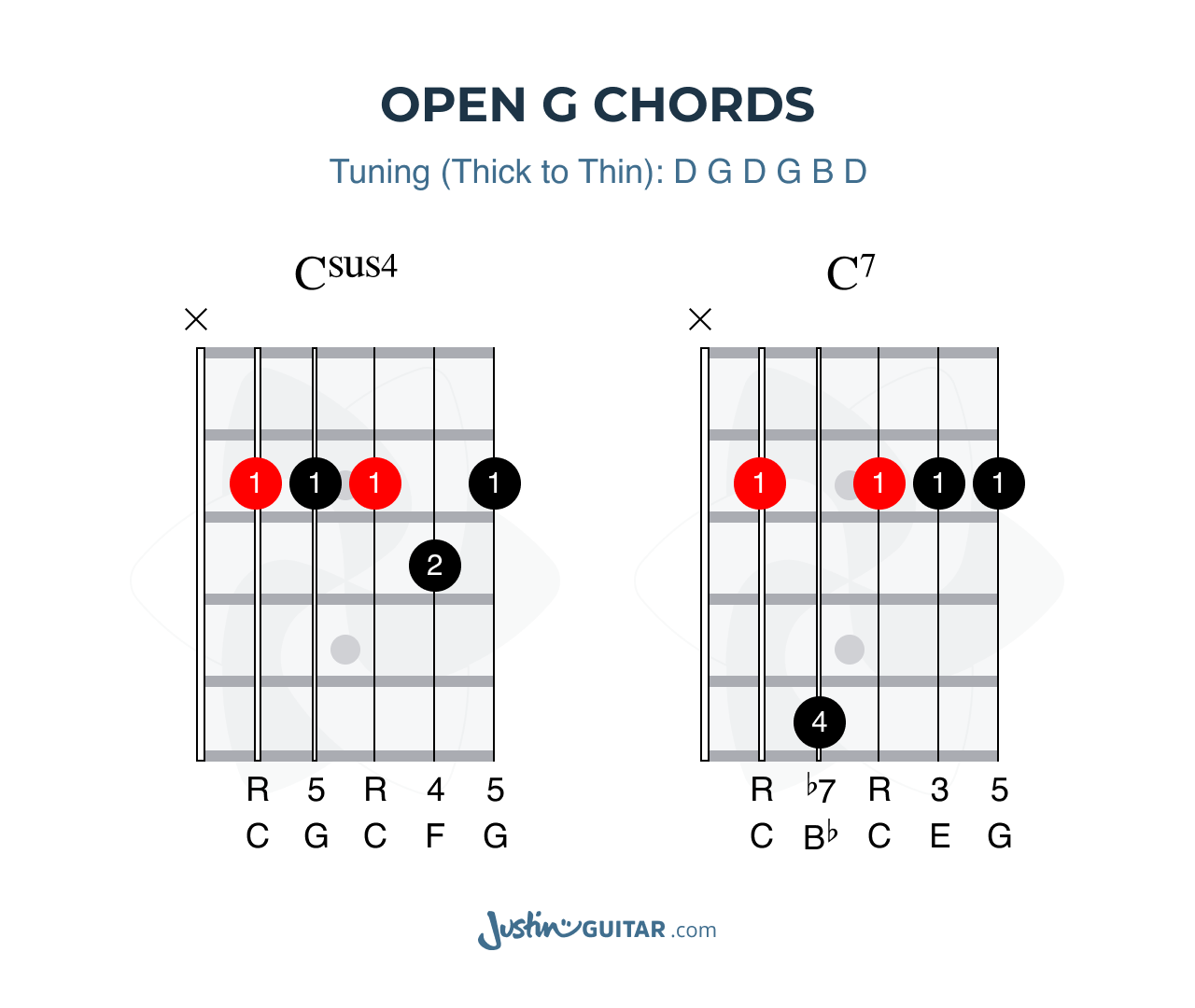JustinGuitar.com uses cookies to enhance your browsing experience. By continuing to use this site, you consent to the use of cookies. For more detailed information, please review the full Terms & Conditions.
Forgot a gift? No worries! 💘 Get 20% off JustinGuitar Gift Cards—because music is the gift that keeps on playing!
In a previous Food for Thought, we had fun exploring Drop D and Double Drop D. Now - we’re only one step away now from Open G Tuning, which is a foundation Open Chord Tuning and loads of fun to explore! It will open the door to a huge amount of music, especially if you dig The Rolling Stones and slide guitar.
🚨 Missed the previous post? Please - check out Altered Tuning Fun - Part 1 here, so you make the best out of this one!
Now - let’s get stuck in and learn more about how to play Open G Tuning on the guitar!
If you’re in Double Drop D, all you need to do now is lower the A String (String 5, second thickest) down a tone to the note G - you can use String 3 as a reference. If you’re not in Double Drop D, you also need to tune both outside strings down a tone to the note D.
In Open G Tuning, you’re playing the notes DGDGBD when you play all the open strings. As any of you who have studied basic Music Theory will know, those are all notes of a G Major Triad (GBD). Notice that it’s “Open G,” but the lowest note is the note D. If you take off the thickest string, the lowest note becomes the low G which makes more sense - and one of the reasons Keith Richards plays his infamous 5-string Telecaster!
💭 Does that famous Keith Richards guitar make more sense to you now? Let me know in the Discussion section!
In Open G Tuning, chord shapes now start to get a little interesting! Regular chord shapes would need notes on the 6th, 5th, and 1st strings moved up a tone. That’s quite often impossible, but trying it will take you to some interesting places and increase your understanding of both the tuning and the function of chord tones in regular tuning, which is extremely valuable.
The Open A Chord is a great place to start if you move Strings 5 and 1 up a tone. You end up with all the notes of the chord in the one fret, which is easy to barre, and the reason this tuning works so well for slide guitar! The root note is on String 5, but up two frets from where you might usually find the note. So, I find it easier to think of the root on String 3 of the shape, but that requires knowing the notes on the neck well - which you should. :)
The famous Stones move you need to know about is the 6sus4 chord, which you get by adding your 2nd and 3rd fingers in front of the barre, as shown below. Don’t worry about the name - just explore its cool sound!

Just adding the 6th on and off (like in a Blues Shuffle) is a simple and super effective move, and the sus4 on its own is easy and sounds cool. Change the 6th into a dominant 7th by moving it up one fret.
💡 You can also try two frets higher than the barre on String 3! That gets you an add9 chord, a really tasty sound to mix with the sus4 or the 6. Try it!

Playing a Sus 4 and also a 7 chord are also fun extensions to experiment with - ones you will hear for sure on many Rolling Stones songs and any band that they influenced (like MANY!)

Now you have lots of cool grooves to explore! Can you figure out how to play a 12 Bar Blues shuffle using that grip? Try it on your own!
🚨 Next - we’ll explore how to do that! But if you can do it, don’t read the answer. Just grab your guitar and go play!
So, G is open, C is fret 5, and D is fret 7. Remember, G is also at the 12th fret. Try the straight bar and then add the 6th in the basic shuffle groove on beats 2 and 4.
If you want to get experimenting with slide guitar, now’s your chance. :) I have an Introduction to Slide Guitar lesson for beginners, but here are the main tricks to play slide guitar and sound great:
Don’t press it down very hard. The slide should only touch the strings, never the frets.
Try to mute the strings behind the slide with the fingers on the nut side of the slide.
I find playing slide with a pick near impossible. So, you might like to start doing it fingerstyle and muting (with your strumming hand) any strings you don’t want to ring out.
But have fun! Don’t worry too much about what you’re doing and why if you are new to slide guitar. The best trick is to enjoy the ride and the fresh sounds you may not have explored before.
A fun place to start is Little Red Rooster by The Rolling Stones, basically a Blues in G - so the info above plus your ears should get you most of the way there! Listen and try to emulate the slides and the vibrato.
If you are a more experienced Open G player, start trying to find other chords, pick an open chord and figure out how you might play it if String 1, 5, and 6 are up a tone and see what happens.
🎶 Some great (non-slide) examples of Open G tuning are Brown Sugar by The Rolling Stones, Romeo & Juliet by Dire Straits, and Bohemian Like You by the Dandy Warhols.
If you want to solo in Open G (and if you’re playing a blues, that might well come up!), remember that you can play on Strings 2/3/4, and nothing changes! If you want to get out onto the String 1, 4, or 5, just move the notes up a tone.
It might sound complex, but it’s just practice and experimenting! It’s not difficult when you’ve played around with it a bit – but you won’t have so many pet licks to explore! Remember that most Blues solos are played mainly on the thinnest four strings anyway, so you just need to shift notes on String 1 up a tone. Or do you? Try all your favorite licks and see how they sound – some will be awesome, so will not. Let your ears guide you more than your brain!
Re-tuning is nothing to be afraid of, and for creative guitarists, it can breathe a lot of new life into the instrument! Chords have a fresh resonance, and you’ll play new sounds that you just can’t get in regular tunings.